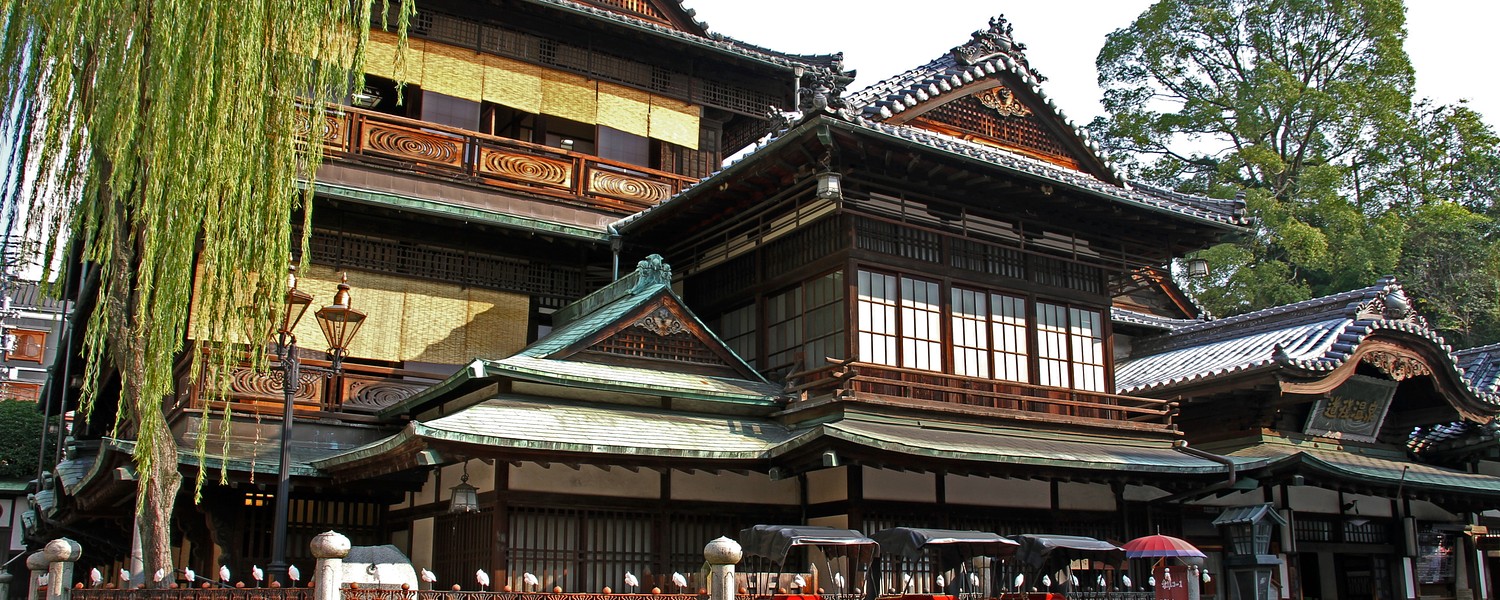
Provided by:
Kevin Autret/Shutterstock.com

Our travel guides are free to read and explore online. If you want to get your own copy, the full travel guide for this destination is available to you offline* to bring along anywhere or print for your trip.
*this will be downloaded as a PDF.Price
€4,95
The City
The guide was updated:
Matsuyama, the capital of Ehime Prefecture and the largest city on Shikoku Island is a destination that beautifully blends history, culture, and natural beauty. Its name, meaning 'pine mountain', hints at the serene landscapes that surround the city.
Matsuyama is also renowned for its vibrant culinary scene, where visitors can savour regional specialities such as sea bream, wild boar, and exquisite sake.
One of the city’s most iconic landmarks is Dogo Onsen, Japan’s oldest hot spring bathhouse. Featured in the Michelin Green Guide and famed as the inspiration for the beloved animation 'Spirited Away', Dogo Onsen offers a timeless experience. Equally captivating is Matsuyama Castle, perched atop a hill in the city’s heart, offering stunning panoramic views.
The city is also a spiritual hub, with eight of the eighty-eight temples of the Shikoku Pilgrimage located here. Among these, Ishiteji stands out with its intriguing network of tunnels hidden in the hillside, while Taisanji and Jodoji provide glimpses into the city’s 8th-century Buddhist heritage. Major Shinto shrines such as Isaniwa Jinja and Tsubaki Jinja further enrich the city’s spiritual landscape.
Matsuyama’s cultural significance is also profound. The city was once home to the revered haiku poet Masaoka Shiki, whose former residence, the Shiki-do, along with the Shiki Memorial Museum, attracts literature enthusiasts from around the world. Matsuyama’s literary connections extend to Natsume Soseki’s novel Botchan and several works by Shiba Ryotaro, including the acclaimed Saka no Ue no Kumo (Clouds Above the Hill). This novel became the centrepiece of a significant cultural initiative, leading to a popular NHK drama adaptation and the creation of a museum designed by the esteemed architect Tadao Ando. Another cultural gem is the Itami Juzo Museum, dedicated to the celebrated film director.
Despite its rich history and cultural offerings, Matsuyama retains a charming, compact feel. The city’s centre is served by a nostalgic tram system, featuring vintage cars from the 1950s and 60s, alongside a replica steam train, the Botchan Ressha. Encircled by mountains and dotted with hills, Matsuyama exudes a green, rural charm. The city’s proximity to the pristine beaches of the Seto Inland Sea further enhances its appeal. Amidst the modern developments, Matsuyama preserves its architectural heritage, with numerous buildings from the Meiji Period and earlier, including the opulent Bansuiso Villa, designed by Shichiro Giko.
Matsuyama is also renowned for its vibrant culinary scene, where visitors can savour regional specialities such as sea bream, wild boar, and exquisite sake.
One of the city’s most iconic landmarks is Dogo Onsen, Japan’s oldest hot spring bathhouse. Featured in the Michelin Green Guide and famed as the inspiration for the beloved animation 'Spirited Away', Dogo Onsen offers a timeless experience. Equally captivating is Matsuyama Castle, perched atop a hill in the city’s heart, offering stunning panoramic views.
The city is also a spiritual hub, with eight of the eighty-eight temples of the Shikoku Pilgrimage located here. Among these, Ishiteji stands out with its intriguing network of tunnels hidden in the hillside, while Taisanji and Jodoji provide glimpses into the city’s 8th-century Buddhist heritage. Major Shinto shrines such as Isaniwa Jinja and Tsubaki Jinja further enrich the city’s spiritual landscape.
Matsuyama’s cultural significance is also profound. The city was once home to the revered haiku poet Masaoka Shiki, whose former residence, the Shiki-do, along with the Shiki Memorial Museum, attracts literature enthusiasts from around the world. Matsuyama’s literary connections extend to Natsume Soseki’s novel Botchan and several works by Shiba Ryotaro, including the acclaimed Saka no Ue no Kumo (Clouds Above the Hill). This novel became the centrepiece of a significant cultural initiative, leading to a popular NHK drama adaptation and the creation of a museum designed by the esteemed architect Tadao Ando. Another cultural gem is the Itami Juzo Museum, dedicated to the celebrated film director.
Despite its rich history and cultural offerings, Matsuyama retains a charming, compact feel. The city’s centre is served by a nostalgic tram system, featuring vintage cars from the 1950s and 60s, alongside a replica steam train, the Botchan Ressha. Encircled by mountains and dotted with hills, Matsuyama exudes a green, rural charm. The city’s proximity to the pristine beaches of the Seto Inland Sea further enhances its appeal. Amidst the modern developments, Matsuyama preserves its architectural heritage, with numerous buildings from the Meiji Period and earlier, including the opulent Bansuiso Villa, designed by Shichiro Giko.


